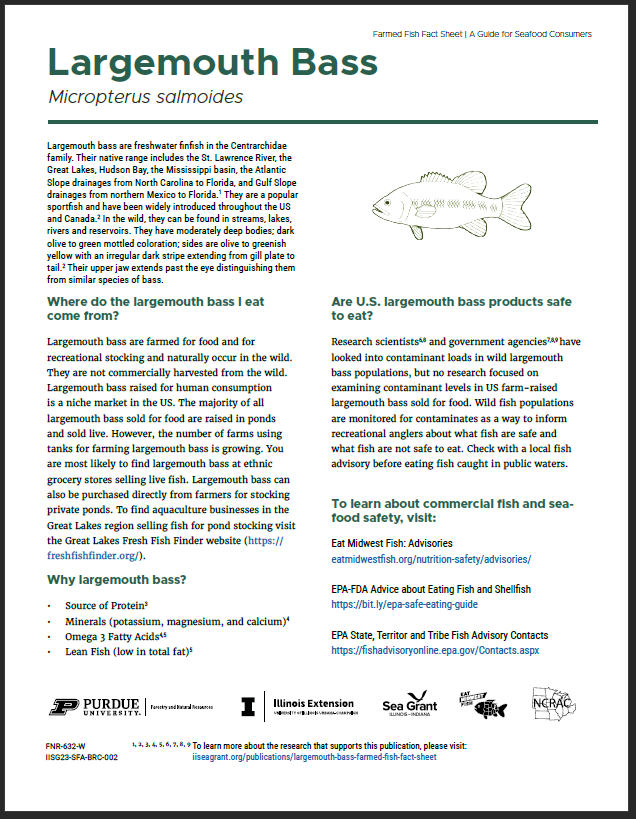Resources Publications and Products

File Size: 3.61 MB
Media Type:
Fact Sheet | Brochure | Poster | Extension Report | Research SummaryPublication Number:
IISG23-SFA-BRC-002Pages:
2Description:
This is the ninth in a series of consumer guides that describe fish and shellfish farmed in the Midwest region of the United States. (See Atlantic Salmon Farmed Fish Fact Sheet, Walleye Farmed Fish Fact Sheet, Yellow Perch Farmed Fish Fact Sheet, Tilapia Farmed Fish Fact Sheet, Rainbow Trout Farmed Fished Fact Sheet, Pacific White Shrimp Farmed Fish Fact Sheet, American Paddlefish Farmed Fish Fact Sheet, and Channel Catfish Farmed Fish Fact Sheet). The fact sheet also includes culinary characteristics, cooking tips and a recipe for Pan Fried Largemouth Bass with Garlic Herb Sauce.
References:
- Fuller, P., Neilson, M., and Procopio, J., 2022, Micropterus salmoides (Lacepède, 1802): U.S. Geological Survey, Nonindigenous Aquatic Species Database, Gainesville, FL. Available online: https://nas.er.usgs.gov/queries/factsheet.aspx?SpeciesID=401#:~:text=Native%20Range%3A%20Largemouth%20Bass%20are,and%20south%20to%20the%20Gulf
- National Audubon Society. 2002. National Audubon Society Field Guide to Fishes. Chanticleer
Press, Inc. - Portz, L. and Cyrino, J.E.P. (2003), Comparison of the amino acid contents of roe, whole body and muscle tissue and their A/E ratios for largemouth bass Micropterus salmoides (Lacepéde, 1802). Aquaculture Research, 34: 585-592. Available online: https://doi.org/10.1046/j.1365-2109.2003.00834.x
- Zou, J., Zhong, L., Song, C., Hu, G., Qiu, L., & Chen, J. (2022). Effects of different diets on fatty acid composition and nutritional values of largemouth bass (Micropterus salmoides). Aquaculture Research, 53, 2287– 2297. Available online: https://doi.org/10.1111/are.15747
- Branciari R, Franceschini R, Roila R, Valiani A, Pecorelli I, Piersanti A, Haouet N, Framboas M, Ranucci D. Nutritional Value and Contaminant Risk Assessment of Some Commercially Important Fishes and Crawfish of Lake Trasimeno, Italy. International Journal of Environmental Research and Public Health. 2020; 17(7):2545. Available online: https://doi.org/10.3390/ijerph17072545
- Karouna-Renier, N., Snyder, R. A., Lange, T., Gibson, S., Allison, J., Wagner. M., Ranga, R. k.. 2011. “Largemouth Bass (Micropterus Salmoides) and Striped Mullet (Mugil Cephalus) as Vectors of Contaminants to Human Consumers in Northwest Florida.” Marine environmental research 72.3 (2011): 96–104.
- United States Environmental Protection Agency. (2001). Charles River Fish Contaminate Survey. Available online: https://www.epa.gov/sites/default/files/2015-10/documents/charles-fish-contaminant-survey.pdf
- “Accumulation of Pollutants in Fish and Shellfish from the Northwest Florida Region
Final Report: Center for Environmental Diagnostics and Bioremediation and Research Ecologist USGS Patuxent Wildlife Research Center. (2009). Accumulation of Pollutants in Fish and Shellfish from the Northwest Florida Region Final Report. Available online: https://pages.uwf.edu/cedb/PERCH_Accumulation_of_pollutants_in_fish_and_shellfish.pdf - Department of State Health Services, Division for Regulatory Services, Policy, Standards and Quality Assurance Unit, Seafood and Aquatic Life Group. (2015). Characterization of potential Adverse Health Effects Associated with Consuming Fish from Fosdic Lake, Tarrant County, Texas.
Recommended Citation
Shambach, Amy and Carlton, Stuart. Largemouth Bass Farmed Fish Fact sheet. Illinois-Indiana Sea Grant Report: IISG23-SFA-BRC-002. https://iiseagrant.org/publications/largemouth-bass-farmed-fish-fact-sheet.
